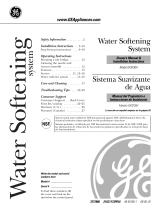8
Step-by-step installation instructions.
4A. CONNECTING A RIGID VALVE DRAIN TUBE
• To adapt a copper drain tube to the softener, use a hacksaw to cut the barbed end
from the drain fitting as shown in Fig. 4A. Rotate the drain fitting so the cutting
blade clears the valve housing to prevent damage to valve. Buy a compression
fitting (1/4″female pipe thread x 1/2″O.D. tube) and needed tubing from your
local hardware store.
5. INSTALL THE BRINE TANK OVERFLOW FITTINGS AND HOSE
• Insert the rubber grommet into the 3/4″ diameter hole in the brine tank sidewall
as shown in Fig. 5.
• Push the end of the hose adapter elbow into the grommet as shown in Fig. 5.
• Attach a length of hose (use remaining hose from Step 4) to the hose adapter
elbow. Use a hose clamp to hold it in place.
• Locate the other end of the hose at the drain point. DO NOT ELEVATE this hose
higher than the elbow on the brine tank.
IMPORTANT: DO NOT TEE OVERFLOW HOSE TO VALVE DRAIN HOSE.
NOTE: This drain is for safety only. If the cabinet (brine tank) should over-fill with
water, the excess is carried to the drain.
6. INSTALL GROUNDING CLAMPS AND WIRE
DANGER: Failure to properly attach ground wire could result in electrical shock.
• If plumbing is metal, to maintain electrical ground continuity in the house
cold water piping, install the included ground clamps as shown in Fig. 6.
Be sure the pipes are clean under the clamps to assure good contact.
7. FLUSH PIPES, EXPEL AIR FROM SOFTENER, AND TEST YOUR
INSTALLATION FOR WATER LEAKS:
CAUTION: To avoid water or air pressure damage to softener inner parts,
be sure to do the following steps in exact order.
A. Fully open 2 cold soft water faucets nearby the softener.
B. Place bypass valve in “bypass” position by pushing the stem inward.
C. Fully open the house main water pipe shutoff valve. Observe a steady flow from
both faucets opened in step A, above.
D. Place bypass valve in the “service” position EXACTLY as follows. KEEP SOFT
WATER FAUCETS OPEN.
SLOWLY pull or slide the valve stem (out) toward “service,” pausing several
times to allow the softener to pressurize slowly.
E. After about 3 minutes, open a HOT water faucet for 1 minute, or until all air
is expelled, then close. NOTE: If water appears cloudy or has salty taste,
allow to run for several more minutes, or until clear.
F. Close all water faucets.
G. Check your plumbing work for leaks and fix right away if any are found.
Be sure to observe previous caution notes.
H. Turn on the gas or electric supply to the water heater. Light the pilot, if applicable.
Fig. 4A
Fig. 5
Fig. 6
Clamp (2)
Ground
wire
From valve outlet
To valve inlet
To sewer
drain
Overflow drain hose
Hose clamp
Grommet
Clip
1/4″NPT threads
Barbs
1/2″O.D.
copper tube (not
furnished)
Cut barbs
from drain
fitting
Compression fitting, 1/4″
NPT X 1/2″O.D. tube (not
furnished)
Do not connect to valve
drain hose.
8. ADD WATER AND SALT TO THE BRINE TANK:
• Lift the cabinet (brine tank) cover. Add about 3 gallons of water into the tank. Do not add into the brinewell.
• Fill tank with NUGGET, PELLET or coarse SOLAR water softener salt with a purity of 99.5% or higher. Do not use rock, block,
granulated, and ice cream-making salts, or salt with iron-removing additives (except for Diamond Crystal® Red•Out® brand salt).
Salt storage capacity is approximately 200 lbs. Keep the salt hole cover in place on the softener unless servicing the unit or
refilling with salt.
NOTE: If the softener is installed in a humid basement or other damp area, it is better to fill the tank with less salt, more frequently.
Eighty to 100 lbs. of salt will last for several months, depending on water hardness, family size and water softening system model.
9. CONNECT TO ELECTRICAL POWER:
• If transformer wiring is not visible at the back of the control head, remove control cover. DO NOT PULL ON OR DISCONNECT
WIRING. Locate the long wire with “U” shaped connectors on one end. Route this wire through the rear of the control housing.
Replace the control cover.
• Fasten the 2 power cable lugs (“U” shaped connectors) to the 2 screws on the transformer, and tighten the screws. Then, plug
the transformer into the electrical outlet.
• The softener works on 24 volt-60Hz electric power. The included transformer changes standard 120 volt AC house power to
24 volts. Plug the transformer into a 120 volt outlet only. Be sure the outlet is always live so it can not be switched off by mistake.
10. PROGRAM THE CONTROL:
• See Programming the Control section.
Hose adapter




















